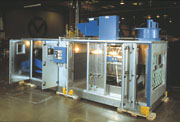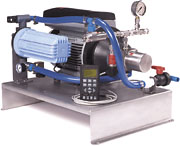
Munters Corp. (Fort Myers, FL) introduced its HUMIdek® evaporative humidifying system that the company says can solve winter humidity problems. The system humidifies air through direct evaporation of water into the air. According to the manufacturer, the system delivers precise humidity control by using solenoid/flow valves. Also, the evaporative media surface doubles as a sound attenuator, which Munters claims will improve the indoor environment.
The HUMIdek module, once installed, will regulate itself. By varying the amount of water introduced to the media, the air is said to be humidified more evenly and more precisely.
The Munters Dehumidification Division also introduced its Humidity Control Unit (HCU), a desiccant dehumidification system that the company says can control the humidity independently of the temperature. The HCU has been designed to treat 100% makeup air and can work in conjunction with an existing a/c system or energy recovery ventilator (ERV). The HCU was designed to control humidity on an as-needed basis, when the humidity or temperature levels exceed a set point.
“The HCU operates very cost-effectively because all of the energy required for the operation of its desiccant dehumidifier is recycled from cooling components,” said Brian Simkins, national accounts manager for Munters.
Munters has released its DryCool Dehumidification System (DDS), another desiccant system, which has been designed with fewer parts. This, according to Munters, improves end-user cost efficiency and decreases lead time. The entire product line is designed with fewer than 10 double-wall panels. It also features removable panels and floors flush with the door jamb to facilitate cleaning.
SG America (Frederick, MD) introduced the E-Save™ desiccant dehumidifier, which uses a microturbine power generator with the company’s patented evaporative cooling technology. The unit can recover thermal energy discharged from the microturbine to reactivate the desiccant.
The dehumidifiers are also available as matched units to several microturbines, and can be modified to accept recovered energy from other heat sources. The company says it believes that the E-Save is perfect for the Department of Energy’s Distributive Energy Resource Program.
SG America also displayed the DrySorb. According to the company, it is the first dehumidifier to incorporate desiccant and conventional cooling technologies into one packaged unit. Heat captured from the unit’s condenser is utilized to reactivate the desiccant.
MORE ENERGY SAVINGS
Nautica Dehumidifiers(Huntington Station, NY) gave information on its Multiple Small Plate (MSP™ ) technology. The product is not new, but the concept, according to Nautica, can cut energy costs up to 50%.Humid air flows through the first pass of a plate-type air-to-air heat exchanger for precooling and initial dehumidification. This precooled air then passes two more times over conventional cooling coils for final cooling and dehumidification. Finally, the dehumidified air is drawn back through the opposite side of the heat exchanger, where it absorbs heat from incoming air and continues to the hvac system.
Stulz Air Technology Systems, Inc. (SATS) (Frederick, MD) also introduced an energy-saving humidifier. The manufacturer says its Ultrasonic Humidifier can provide contaminant-free humidification, and offers operational and energy savings.
According to the company, the Ultrasonic Humidifier’s adiabatic humidification process requires 93% less electric energy than conventional humidifiers using technologies such as electrode boiler and infrared. The system uses deionized water for cleaner, mineral-free humidification.
SATS also displayed DesicAir™ dry desiccant dehumidification products, which the manufacturer says remove moisture from the airstream. The line incorporates reactivation energy conservation, which reduces operating costs.
The company’s STEAMaster™ electrode humidification systems use state-of-the-art microprocessor controls, resulting in a more cost-effective humidity control, the company says.

FURTHER DEVELOPMENTS
A number of other humidification and dehumidification manufacturers were present at the expo to either display existing product lines or to showcase additions designed to enhance their existing offerings.Dri-Steem (Minneapolis, MN), known for its Gas-To-Steam (GTS) humidifiers, gave attendees a look at the new Dri-Calc II software. It allows users to calculate the humidification load, determine the absorption distance and dispersion method arrangement, and allows the selection of proper humidification equipment.
EWC Controls (Englishtown, NJ) provided attendees with information on its whole-house humidifiers, such as the Autoflow steam unit. The system has a built-in computer chip and an automatic flush system that will drain the humidifier every 12 hrs of operation. The product can also operate and turn the fan on independently of the furnace.
Herrmidifier (Sanford, NC) displayed its steam-to-steam humidification product, the Herrmidisteam. The SS Series (for raw water applications) has a heat exchanger constructed of copper with nickel plating. The SS-DI Series is for use with deionized or reverse-osmosis water applications.
Danfoss (Milwaukee, WI) has released its Danfoss Nessie® Plug&Spray™ units for cold steam hvac humidification. The company says the Nessie can be used for ventilation and air conditioning systems, agricultural humidification of livestock, direct humidification in production and storage, and more.
The advantages of the unit include small space requirements, minimum energy and water consumption, low maintenance, and low noise levels, the company says. It is also suitable for reverse-osmosis water.
Aprilaire (Madison, WI) showcased a wide variety of hvac equipment, including its line of automatic humidifiers. The products have been around for a few years now, but they promise better humidification by supplying 50% more moisture.
The automatic humidifiers use technology that enables them to measure outdoor temperatures and adjust the relative humidity indoors. The humidifiers check the outdoor temperature approximately 86,000 times a day, the company says.
Publication date: 02/04/2002


Report Abusive Comment